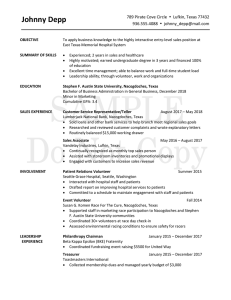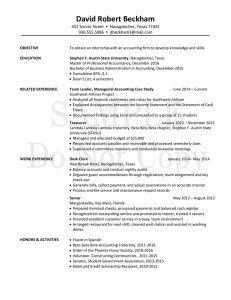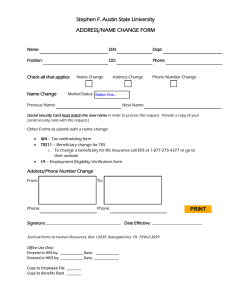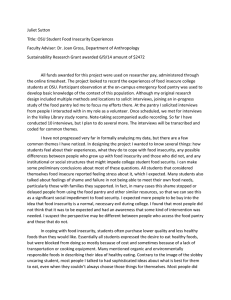Printing:
advertisement
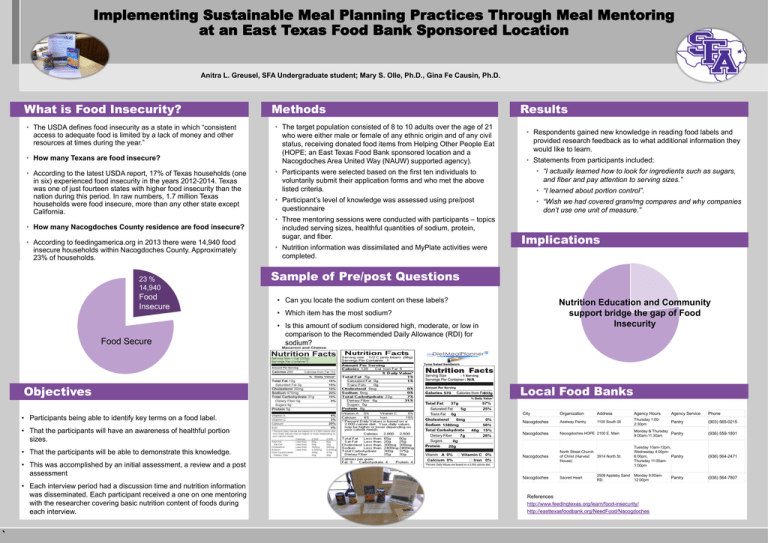
Implementing Sustainable Meal Planning Practices Through Meal Mentoring at an East Texas Food Bank Sponsored Location Anitra L. Greusel, SFA Undergraduate student; Mary S. Olle, Ph.D., Gina Fe Causin, Ph.D. What is Food Insecurity? • The USDA defines food insecurity as a state in which “consistent access to adequate food is limited by a lack of money and other resources at times during the year.” • How many Texans are food insecure? • According to the latest USDA report, 17% of Texas households (one in six) experienced food insecurity in the years 2012-2014. Texas was one of just fourteen states with higher food insecurity than the nation during this period. In raw numbers, 1.7 million Texas households were food insecure, more than any other state except California. • How many Nacogdoches County residence are food insecure? • According to feedingamerica.org in 2013 there were 14,940 food insecure households within Nacogdoches County. Approximately 23% of households. 23 % 14,940 Food Insecure Food Secure Objectives • Participants being able to identify key terms on a food label. • That the participants will have an awareness of healthful portion sizes. • That the participants will be able to demonstrate this knowledge. • This was accomplished by an initial assessment, a review and a post assessment. • Each interview period had a discussion time and nutrition information was disseminated. Each participant received a one on one mentoring with the researcher covering basic nutrition content of foods during each interview. ` Methods • The target population consisted of 8 to 10 adults over the age of 21 who were either male or female of any ethnic origin and of any civil status, receiving donated food items from Helping Other People Eat (HOPE; an East Texas Food Bank sponsored location and a Nacogdoches Area United Way (NAUW) supported agency). Results • Respondents gained new knowledge in reading food labels and provided research feedback as to what additional information they would like to learn. • Statements from participants included: • Participants were selected based on the first ten individuals to voluntarily submit their application forms and who met the above listed criteria. • “I actually learned how to look for ingredients such as sugars, and fiber and pay attention to serving sizes.” • Participant’s level of knowledge was assessed using pre/post questionnaire • “Wish we had covered gram/mg compares and why companies don’t use one unit of measure.” • Three mentoring sessions were conducted with participants – topics included serving sizes, healthful quantities of sodium, protein, sugar, and fiber. • Nutrition information was dissimilated and MyPlate activities were completed. • “I learned about portion control”. Implications Sample of Pre/post Questions • Can you locate the sodium content on these labels? Nutrition Education and Community support bridge the gap of Food Insecurity • Which item has the most sodium? • Is this amount of sodium considered high, moderate, or low in comparison to the Recommended Daily Allowance (RDI) for sodium? Local Food Banks City Organization Address Agency Hours Agency Service Phone Nacogdoches Azelway Pantry 1100 South St Thursday 1:002:30pm Pantry (903) 565-0215 Nacogdoches Nacogdoches HOPE 2100 E. Main Monday & Thursday Pantry 9:00am-11:30am (936) 559-1801 Nacogdoches North Street Church of Christ (Harvest 3914 North St. House) Tuesday 10am-12pm, Wednesday 4:00pm6:00pm, Pantry Thursday 11:00am1:00pm (936) 564-2471 Nacogdoches Sacred Heart Monday 9:00am12:00pm (936) 564-7807 2508 Appleby Sand RD. References http://www.feedingtexas.org/learn/food-insecurity/ http://easttexasfoodbank.org/NeedFood/Nacogdoches Pantry
